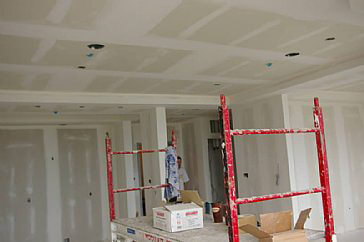Gypsum
 7/10/2012 at 6:38:06 AM
7/10/2012 at 6:38:06 AM
I want to know why people say that you have to hang drywall on wall on the horisontal and not vertical.
Why cant i stand up my sheets of drywall, this way there are less joints.
 7/10/2012 at 10:29:11 AM
7/10/2012 at 10:29:11 AM
It would be our pleasure to discuss this with you over the phone. Please contact us at your earliest convenience.
Christine Smith
TrevNor Construction
www.trevnorconstruction.com
613-983-5595
 7/10/2012 at 10:50:40 AM
7/10/2012 at 10:50:40 AM
Commercially we stand drywall all the time on steel studs properly measured.
But we find with wood construction two things first room size of 8' 9' or 12' can be done with one sheet no butt joints. and 2 most wood framing is not accurate enough to stand sheets for long runs and still screw off properly.
I find finishing must faster with sheets stood up and drywall install is faster and neater as well so there really is no reason to have to lay down sheets if your framing is good.

 7/10/2012 at 11:11:57 AM
7/10/2012 at 11:11:57 AM
Until no fire rating is involved, really it is up to you how you place your boards. As Ron mentioned, most of the time for residential projects it is really much easier to lay boards down.
When fire rating is required, drywall MUST be standing vertical.
 7/10/2012 at 12:29:52 PM
7/10/2012 at 12:29:52 PM
Standing up your sheets will take 1/3 more tape and mud to finish your wall, If a wall measures 24,' you will have 24' of tape where the wall meets the ceiling(this is always the same laying down or vertical)
Now every 4' 'there is a vertical joint from floor to ceiling if your ceiling height is 8', count from the corner of the wall, every 4 feet, and you will come up with a total of 56' lineal feet of tape+24' along the ceiling which adds up to 80' of tape.
Laying down your sheets on the same wall, your lineal feet of tape will be 24' along the ceiling, and 24' down the center of the wall,plus 12' of tape for the but ends of the sheets,(there will be 3 but joints in the wall, 4 ' each) which adds up to 60' of tape. This adds to your cost of taping the wall.
In wood frame housing lay down application of drywall is used in most cases. Commercial applications often require drywall to be stood up for fire rated walls.
I hope this is enough info for you.
 7/10/2012 at 7:02:37 PM
7/10/2012 at 7:02:37 PM
On advice from drywallers and drywall suppliers, there is absolutely no reason you can't. The idea is to have as few seams as possible and depending on the room size and, as was previouslly mentioned, the accuracy of the construction, the choice is yours. Common sense should prevail.
 7/11/2012 at 12:16:26 PM
7/11/2012 at 12:16:26 PM
You can install drywall vertically. Installing horizontally is slightly better as the wall will be a bit more rigid.
Paul Justice
 3/24/2013 at 8:29:09 PM
3/24/2013 at 8:29:09 PM
it's just the way we've done it all these years. It also provides some structural rigidity to a house to keep it from wiggling and moving in the wind. There is also a lot less taping in rooms under 12 feet.
Search the TrustedPros directory and discover the best contractors in your area.
Find your home service pro

